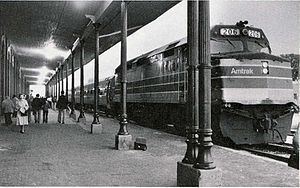Status Discontinued Distance travelled 74 miles (119 km) Last service 13 January 1984 | Ridership 26,000 (1983) Average journey time 1 hour 35 minutes First service 20 January 1975 Stops 5 (3 after 1982) | |
 | ||
Wolv tv newsfeed election special make michigan executive candidates interview
The Michigan Executive was a commuter train operated by Amtrak between Detroit, Michigan, and Jackson, Michigan.
Contents
- Wolv tv newsfeed election special make michigan executive candidates interview
- Talk coldplay
- History
- Description
- End of service
- References
Talk coldplay
History
As Amtrak's mandate did not cover commuter operations Penn Central continued to operate a weekday commuter service between Detroit and Ann Arbor, Michigan after Amtrak had assumed control of its intercity operations. By the mid-1970s Penn Central asked to discontinue the service, citing dwindling ridership and the aging Rail Diesel Cars it used. Amtrak and the state of Michigan agreed to step in, and the Michigan Executive made its first run on January 20, 1975, running between Detroit and Jackson (to the west of Ann Arbor).
Description
In the summer of 1975 the westbound Friday Michigan Executive operated all the way to Chicago, returning the following Sunday. Under Amtrak, ridership increased 50% and peaked at 96,573 in 1979. Chartered buses carried passengers from the Detroit station to downtown Detroit. Declining ridership due to the decline of downtown Detroit, a recession, and ticket price hikes led Amtrak to discontinue the westbound Michigan Executive on June 14, 1982 and eastbound service between Jackson and Detroit was truncated only running from Ann Arbor to Detroit. Returning commuters took the Chicago-Detroit Twilight Limited which was modified adding stops to accommodate former westbound Executive passengers. By 1983, annual ridership had fallen to 26,000.
End of service
Amtrak completely discontinued the remainder of the Michigan Executive on January 13, 1984, after Michigan withdrew its support citing low ridership. State transportation officials estimated that the discontinuance would save $200,000/year, and daily ridership had dwindled below 60.
